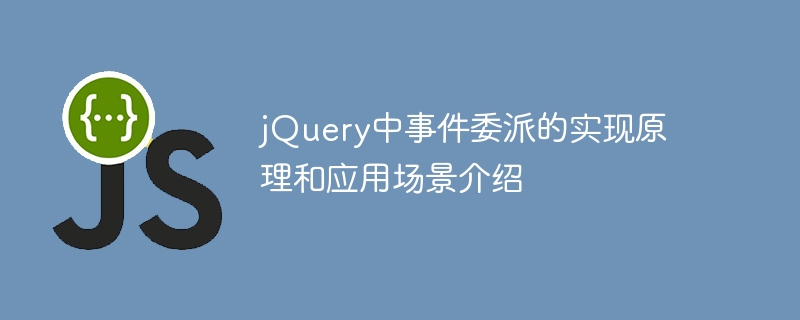Home >Web Front-end >JS Tutorial >Introduction to the implementation principles and application scenarios of event delegation in jQuery
Introduction to the implementation principles and application scenarios of event delegation in jQuery
- PHPzOriginal
- 2024-02-28 13:06:031411browse

jQuery is a JavaScript library widely used in front-end development. Through its simple API, it provides convenient and fast methods to operate the DOM and handle events. Among them, event delegation (Event Delegation) is a very important and commonly used feature in jQuery. This article will introduce the implementation principles and application scenarios of event delegation, and provide specific code examples.
Implementation Principle of Event Delegation
The core idea of event delegation is to use the event bubbling mechanism to uniformly bind event handlers to the parent element and handle the events of its child elements through event delegation. . The specific implementation process is as follows:
- First, bind an event handler to the parent element and listen for specific events (such as click, mouseover, etc.).
- When an event is triggered, the event will propagate upward in the DOM tree until the root node.
- In the event propagation process, by judging the target element of the event, you can determine which sub-element the event is propagated from.
- Perform corresponding operations based on the relevant attributes or identifiers of the target element.
Through event delegation, we can reduce the number of event handlers, improve performance, and enable dynamically generated elements to respond to events.
Application scenarios of event delegation
- Click events of list elements
Suppose we have a list that contains multiple children Element, we can bind click events to the entire list element and handle click events of sub-elements through event delegation.
$("#list").on("click", "li", function() {
// 在这里处理子元素li的点击事件
});- Action buttons in table elements
In a table, there is usually a column containing action buttons (such as delete, edit, etc.), We can handle click events of these action buttons through event delegation.
$("#table").on("click", ".btn-delete", function() {
// 在这里处理删除按钮的点击事件
});
$("#table").on("click", ".btn-edit", function() {
// 在这里处理编辑按钮的点击事件
});- Event handling of dynamically generated elements
If there are some elements in the page that are dynamically generated through ajax requests or other methods, we can pass Event delegation handles events for these elements without having to bind individual event handlers to each element.
$("#container").on("click", ".dynamic-element", function() {
// 在这里处理动态生成元素的点击事件
});Conclusion
Through event delegation, we can handle events of DOM elements more efficiently, reduce duplicate code, and improve page performance. In actual projects, proper use of event delegation can make the code more concise and easier to maintain. I hope this article will help you understand the principles and application scenarios of event delegation.
The above is the detailed content of Introduction to the implementation principles and application scenarios of event delegation in jQuery. For more information, please follow other related articles on the PHP Chinese website!
Related articles
See more- JavaScript event bubbling, event capturing and blocking default event code examples
- JQuery simulates click events and automatically triggers events
- How to loop output array elements in JQuery
- Introduction to docker's application scenarios and advantages
- What can the Vue computed property do? Brief analysis of application scenarios

